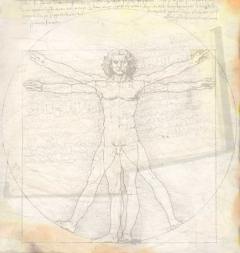|
I’m
presuming it is a constellation.
The
parenthetical - piama lau - what might this mean?
Piama
isn’t in Pukui’s dictionary, but pi and ama are.
Pi
means smoldering, sputtering as a waning fire might. And pipi has a meaning of
twinkling, as stars.
Ama
is the float on an outrigger canoe.
Lau
means many, 4 hundred, pattern, and a kind of net.
My
guess is that the piama lau, the triangular boat, is a constellation or perhaps part of the Milky Way that is to the celestial
west or south of the kohe. It might even be the boat constellation that has Canopus as one
of its stars.
::::::::::::::::::::::::::::::::::::::::::::::::::::::::::::::::::::::::::::::::::::::::::::::::::::::::::::::::::::::::::::::
//////////////////////////////////////////////////////////////////////////////////////////////////////////////////////////////
This
- what is it? - mythoastronomy? cosmology? ?
Grandpa
Ho’okano called it my “study of Hawaiian things,” but it’s not just Hawaiian. In fact the more I
learn
the more universal it reveals itself to be. Anyway, it’s a trail you can’t
walk in a straight line. Or in a hurry.
One
thing leads to another and another and another and I don’t think you can plan the trip.
Anyway I can’t. You just get on and go.
There’s
a wonderful website http://www.d.umn.edu/cla/faculty/troufs/Buffalo/pbwww.html that is a “biography” of Ojibway elder Paul Buffalo in his own words. Tim Roufs of the University of Minnesota at Duluth has put the biography online as a sort of e-book.
I don’t
know what I was googling when I found this site. And I didn’t realize on the first visit how important a book Mr. Buffalo’s
words make. I just bookmarked the site and ran off to look for something else.
One day I was
reading something and the word “traditionalism” was in it. It wasn’t
a familiar word, but it had “traditional” in it so I googled it.
Yikes. Not at all what I expected. Not a bad
thing, just not at all what I expected. This traditionalism refers to universal
esoteric and initiatory spiritual traditions of ancient civilizations and some contemporary cultures. Things like the Makahiki festival’s Hale Wai Ea ceremony, for instance, where the king/chief is ritually
re-initiated through, oh pardon me for the bubble-brained language I’m using here, the actions and symbols of death
- darkness, the skull - and rebirth - emerging from the “womb” that is the Hale Wai Ea.
Anyway, visiting
traditionalism introduced me to some writings and writers with which I was unfamiliar, so I looked some of them up, too. And I discovered that a couple of people whose works were familiar - Mircea Eliade
and Huston Smith, for example - appeared among the traditionalist writers.
I read a few
biographic notes about Mircea Eliade and I was really bothered by something - somehow his traditionalism led to his sympathy
for, perhaps support of, racist facism, specifically of the then young German Nazi movement.
How does universal
esotericism, universal initiatory practice, feed racism? I don’t get it.
But I do get
it. It’s the initiation part, the exclusivity by means of initiation. The inner teachings may be universal, but only the initiated elect are qualified to
know them.
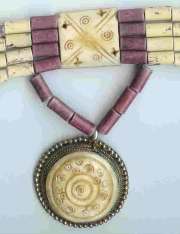
The picture
to the left is of the center part of a choker made of wampum beads and incised bone.
There’s all kinds of symbolism here.
First, it tells
you it’s American Indian. Then the wampum tells you the general regional
tradition area the idea for the choker comes from - northeast U.S., southeast Canada. Then the designs carved in the bone pieces stand
for things, too. The little x-shapes with a hole in the middle are stars. The big X on the square bone piece is a form of a cross and the cross is in the sky,
not on the earth. And so on.
And it’s also just a necklace.
So this initiation
thing, it doesn’t change the meaning of a symbol, but it adds additional meaning/meanings, at each level of initiation
more esoteric and thus more sacred and more secret.
It gave me the
willies to know that things I know to be sacred can also be evil. Actually, they’re
not evil, but they can be used for evil.
And in fact
I already knew that because it’s part of Hawaiian culture, too, and other native cultures. The knowledge and the mana/power is potent, that is possession of it is to possess its potential and how
you exercise that potential, how you manifest it, is what makes it good or evil or indifferent.
Still, I guess
I expected better from someone whose works I admire.
The traditionalists
exclude a great many people right off the top because of the way they use language.
It’s dreadfully overdone language, philosophers’ language:
“Philosophy, considered from the standpoint of its limitations - and it is the limitations of philosophy
that confer upon it its specific character - is based on the systematic ignoring of what has been stated above. In other words, philosophy ignores what would be its own negation; moreover, it concerns itself solely
with mental shemes that, with its claim to universality, it likes to regard as absolute, although from the point of view of
spiritual realization these schemes are merely so many virtual or potential and unused objects, insofar at least as they refer
to true ideas; when, however this is not the case, as practically always occurs in modern philosophy, these schemes are reduced
to the condition of mere devices that are unusable from a speculative point of view and are therefore without any real value.”
That’s
from the first chapter of traditionalist Frithjof Schuon’s book The Transcendent Unity of Religion.

“And if there’s a person who has something
that he carried good, and if he leaves me with that good word and tells me what to do with it, that’s a big gift. Really, it’s a big gift! You stop
for that. You’ve got to go along with what he did, because he gave you
a good word. He gave you a good stone to carry in your pocket.
Sure, you stop
and look at it, put it in your pocket and go along on your way. It’s a
big thing. You have to carry something on you......the older the world gets, the more dangerous it is......There is a thing
behind that sun. There is a thing. If
it isn’t behind the sun, it’s somewhere. One of the stars has it,
maybe the moon’s got it, behind it. But watch that light. When that light shines, it serves you...
...Indians sing
for power, they fast, and they talk to the birds and trees, telling them what their medicine’s for....Ya, talk to the trees.
That’s what you do, and it’s almost then that your power commences.
Then you got power......The sun
is a great thing...Stars! Stars are great too.
Yeah, that’s something. It’s a great earth, and there’s
miles and miles of it. There’s miles and miles of sun too. The Great Manitou is back of the sun, and He’ll take care of that sun.”
Those are a
few of Paul Buffalo’s words. And they’re easy words. Anyone can understand them. And his words are as deep, as
profound, as esoteric as the alphabet people’s. How can that be?
Because the
words Paul Buffalo uses let you understand, let you realize, as much as your experience and knowledge of the moment enables
you to. Ten people hear the same words at the same time, but there isn’t
just one meaning - there are ten meanings, eleven really, counting the speaker who says the words. Back to the Traditionalists. Rene Guenon (1886 - 1951) is
the philosopher most intimately associated with Traditionalism. He was French
and wrote in French and only a few of his works have been available in English. From
what I glean from the little I’ve read by and about him, he viewed the arc of human spiritual history to have been a
devolution/ disintegration moving from Form (or Quality) to Matter (Quantity) which will soon more or less implode (at the
end of the current World Age) in an “inversion” of quality and consequent reign of an Antichrist.
What he calls
the Reign of Quantity, the state we’re in, is guided by the effort to quantify all of reality to measures countable
only by the five human senses, discounting altogether the mysteries of insight, revelation, inspiration, intuition, and the
spirit.
It’s hard
to find argument with that.

I think this
is a good place to talk a little about the symbols of the language of myth.
There’s
ample evidence that our long ago ancestors did not think the earth was flat. Seagoing
peoples were well aware of earth’s curvature from observing objects approaching them from the horizon and from observing
objects on the horizon as the seagoers sailed, drifted, or paddled toward the horizon.
Presumably desert travelers noticed the same phenomena.
In myths the
earth is flat, not because the makers of myth believed it was flat, but because a flat earth lends itself more conveniently
to symbols and metaphors.
Our ancestors
did, however, believe that the earth was the center of the universe and that the sun and moon and planets and stars all revolved
around the earth.

this is the flat earth
and X marks
the spot
you’re
standing on
For most purposes
in the symbolic language the earth is conceived as a flat rectangular plane. In
some stories, though, like the King Arthur stories, the earth is a flat circle.
Now think of
the earth in the middle of the universe.
There’s
space above and space below.
Here’s
the ball of earth suspended in the middle of the universe.
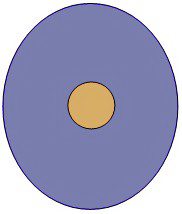
In some creation
stories, like the Hindu stories and the Polynesian stories in which Kanaloa is the creator, the infant universe is a “cosmic egg.”
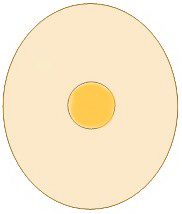
There’s
a reason for that - the egg
works beautifully
as a
visual metaphor
for
the relationship of earth to the universe,
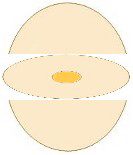
and the opening
of the egg at the middle, well it accomplishes
the same thing
King Arthur’s Round Table does - a circle around a center, or the sky/universe around the earth. We’ll leave egg
for now, but you can see how well it works as a model of the earth within the universe.

So, the flat
earth in a flat plane. There is the “sky above,” often called the
“heavens.” And there is the “sky below,” often called the “underworld.” The sky above is
connected to the sky below by an axis the goes through the center of the earth.
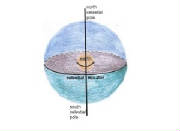
The top of the
axis is the North Pole and the bottom the
South Pole,
and the sky, like the earth, rotates around
the pole.
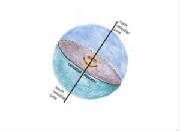
But the earth’s
isn’t pole isn’t straight up. It’s at an angle.
The sun makes
a path around the earth. We call that path the ecliptic.
The ecliptic
is also the band in the sky that contains the twelve constellations of the zodiac.
That means that the sun passes through each constellation during its yearly journey around the earth.
The sky, you’ll
notice, like the earth, has an equator. The places where the ecliptic crosses the equator are the equinoxes - the two times each year, one in the spring and one
in the fall, when night and day last an equal
number of hours.
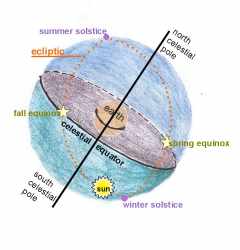
Two other important
solar path days are the solstices. The summer solstice takes place when the sun
is at its
greatest distance
from earth. This day is the longest day of the year.
The winter solstice
takes place when the sun is closest to the earth. This is the shortest day of
the year.
Each of these
four sun events occurs in a predictable pattern of star movement along the horizon and for milennia before our era people watched the sky to prepare for the solstices and equinoxes. And the four constellations in which the sun rose at equinox and solstice dawns are the pillars/posts/supports of
heaven -
- for a while.
|
